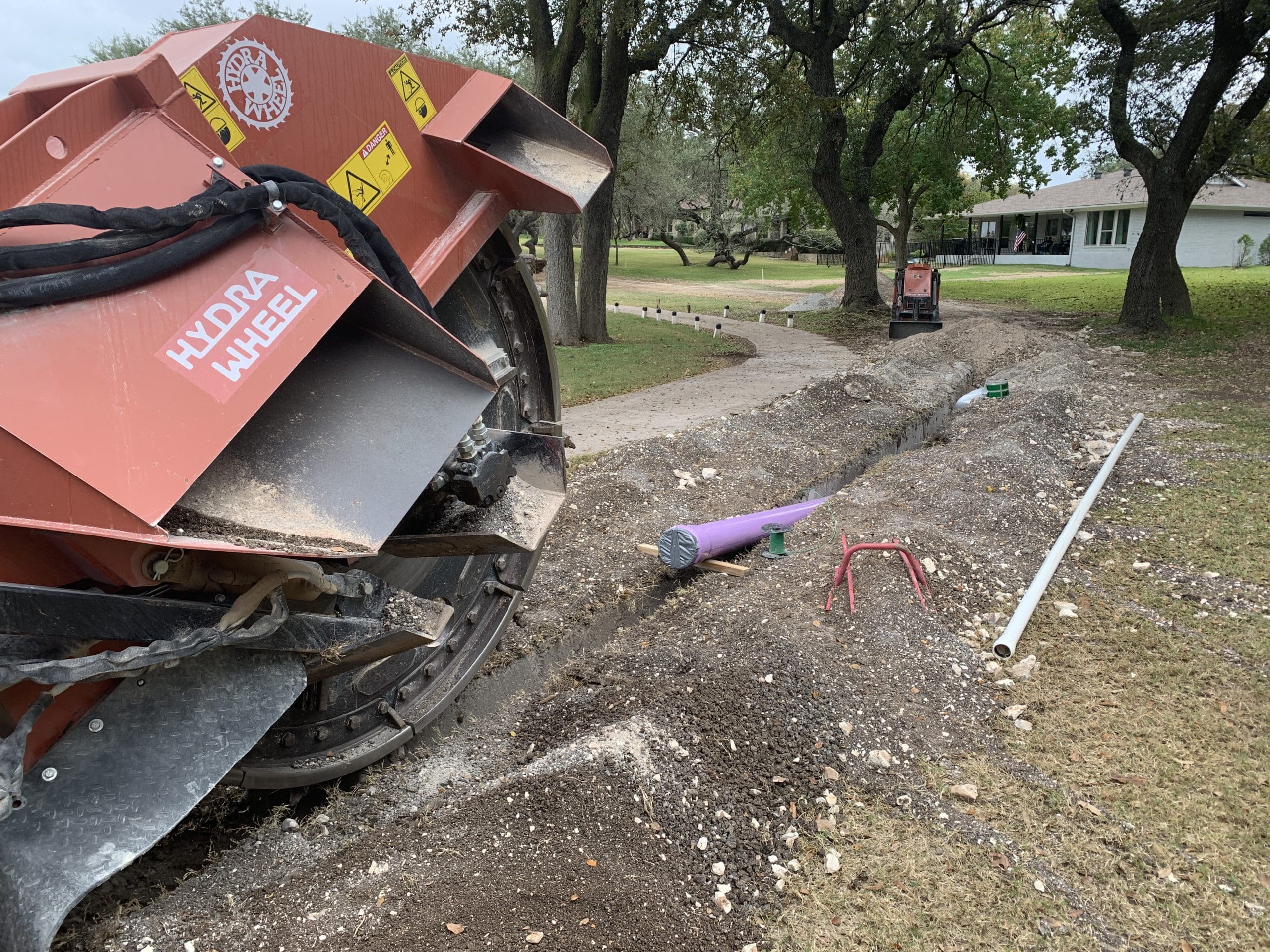ODWW Project Update: Preparing for Phase 1 Connections

Here we are in a brand new year. We made it through 2020 and are ready to tackle whatever 2021 has in store for us!
Our last public meeting on the Out of District Wastewater (ODWW) Project was in May 2019. We had planned to have another in-person gathering Summer 2020, but unfortunately COVID-19 protocols prevented us from making that happen, so we have limited our updates to posts on our website and answering incoming e-mails and phone calls. Customers directly impacted by construction on the main line or Early Connections have been e-mailed.
COVID has definitely been a contender for us this year, making routine work that much harder and special projects…well, let’s just say challenging. Thankfully, none of our staff or their families have been hit hard, but we had a few run ins with the virus that caused us to temporarily disperse our teams to limit interactions. We have also had delays in delivery of supplies. Until a new normalcy is reached, we anticipate continued setbacks to the Project timeline, but our field teams have moved to 6-day instead of 5-day workweeks to make up for lost time as much as possible.
As of now, Regular Connections for Phase 1 of the Project area (the properties around the Live Oak Golf Couse) are scheduled to begin late March/early April 2021. That is just a few months away, so we are busy making preparations for how the added workload will impact the scheduling of our teams.
The Phase 1 Regular Connections start date is heavily influenced by the completion of a lift station and improvements at our S-5 Water Recycling Plant, which was contracted out to Austin Engineering Co., Inc. in March 2020. These improvements are needed before the new main lines we have laid and continue to lay around the Live Oak Golf Course can be used to pump our customers’ wastewater to the plant. Their work is currently in finishing stages and then system testing can begin. Most of this work was completed away from public view, alongside the airstrip at the Lakeway Airpark, impacting residents who already receive wastewater service from LMUD. Thankfully, communication with the customers was abundant and every effort was made to keep taxiways operational with minimal downtime. We tried, as we always do, to address customer comments in a thorough and timely manner. We appreciated all feedback on our work, but one e-mail particularly illustrated what we hope to accomplish:

“Your guys are seemingly doing an incredible job on this project. It makes me wonder how the culture within LMUD started and evolved into what I see today. It appears to me to be not just ‘do the job,’ but rather ‘how can we do this so we leave everything behind better than we found it?’”
– Dave, LMUD customer
Thank you for that, Dave! And for the pizza that you ordered for our entire staff! Construction is never a fun process for all those who are impacted, and we realize that: it’s messy and it always seems to take longer than initially anticipated. The unforeseen obstacles that our field teams address each day abound, from line locates of cable and electric lines that seem to zig-zag their way across the path we need to rock saw to lay our main lines; too hot, cold, and wet weather conditions; or quickly stopping in the middle of a job to address an emergency leak in another part of our service area (yes, the same teams who are working on this project also maintain our water and wastewater lines throughout our entire service area).
Foreseen obstacles also recently impacted the project: two of our 30-plus year veterans retired. Tommy Farrell started with LMUD in 1988 and served as our field team supervisor in his most recent position; he retired this past July after 32 years of service to LMUD. Pauli Delgado started with LMUD in 1990; he retired last month after 30 years of service having most recently the responsibility of managing our team that handles Early Connections. Both men are missed, taking much knowledge with them, but also leaving much behind with our field department crew. Our new field department supervisor, Buster Hopkins started with us in November 2020 and has over 20 years of experience in water and wastewater management. He is joined by team leads Zach Trippe who has been with LMUD since 2010 and Cy Ndefung, a new recruit, who, like Trippe, has shown a knack for attention to detail. We are confident our field teams will continue to leave a legacy of, as Dave said it, not just doing their job, but leaving everything behind better than we found it.

How do we and our customers define “better”? This Project is a huge undertaking (installing a sewer system in an established neighborhood) but it is necessary: with aging, failing septic systems so close to Lake Travis, it could quickly become an environmental hazard, not to mention freeing up space at each property to turn these once-vacation homes into full-time family residences. There are currently two, and about to be three, separate undertakings that make up the workload needed to complete our ODWW Project:
- Main Line Extensions: The main lines are our wastewater pipes that are buried in the ground to which each of our customers’ choosing to opt-in for a sewer connection will be connected to via service lines added to their property. So far, we have run these pipes behind the backyards of properties around the front nine holes of the Live Oak Golf Course, including Sunfish, Seawind, Porpoise, and Lakeway Drive (lines for Phase 1 properties along Dragon and Flamingo have been run as well). We are currently working on laying the remaining lines for the back nine holes, comprising mainly of properties in Phase 1 along Biscayne, Vanguard and Lido. The process for this work includes: Step 1: Mark our path around trees and other obstacles including line locates (so we don’t cut our customers’ internet or electricity), Step 2: rock saw a trench in which the pipes will be buried (this requires heavy equipment and creates lots of dust when the weather is hot and dry), Step 3: Follow regulatory guidelines to lay and bury the pipe (we’re also laying recycled water lines alongside these wastewater lines, which will be available for customers in Phase 1 to connect to for irrigation purposes in the future; details will be supplied at a later date), Step 4: Clean up, make repairs, and revegetate any disturbed landscaping.
- Early Connections: Customers with a failed septic system, building on an empty lot, or planning a remodel may apply for an Early Connection. This connection option would allow the property owner to have their property connected prior to their anticipated connection date on our Project schedule, ahead of their neighbors. We have already made over 40 Early Connections to date, each one presenting a new set of challenges for our install team, taking between three days to two weeks to complete. There is a one-time upfront fee associated with this option and there is no guarantee when the connection will occur. These connections have taken place across the Project’s coverage area and require main line extensions from existing mains to the property. When we begin one of these connections, we notify the surrounding neighbors by e-mail of the impending construction and what to expect.
- Regular Connections: We have not started on Regular Connections yet. This is what we are currently planning for so that we can complete these connections on a tight schedule, while at the same time, continuing the two task areas mentioned above. We plan to start the Phase 1 Regular Connections with properties along Sunfish from hole 1 around to hole 6 of the Live Oak Golf Course. From there, we have a planned route, so if you are in Phase 1 and are curious what your current anticipated connection date is, contact our office. Property owners should only fill out the contract stating their intent to opt-in or decline a connection when it is requested by our office; Stephanie Threinen, our public information liaison, will contact the current customers on file for the account and make sure to get a reply from each property’s owner prior to their anticipated connection date.
Phase 1 Regular Connections are currently expected to begin in late March/early April and take through the end of 2023 to complete. This is based on a projected 85% opt-in rate with our crew’s ability to connect each location in 3.5 days. We anticipate additionally connecting at least two Early Connections each month (this is all in addition to our regular work maintaining and repairing our water and wastewater systems throughout Lakeway). Once the Phase 1 Regular Connections are complete, we will begin collecting contracts from Phase 1 property owners who want to connect to our recycled water system for irrigation as well as Regular Connection contracts from Phase 2 customers along to-be-determined routes. For additional information, visit the Project Timeline post on our website, which is regularly updated.

All opt-in connections include LMUD decommissioning the existing septic system on the property per LCRA guidelines and filing paperwork with them (septic systems in Lakeway are under LCRA’s regulatory control). It will also include our crew’s installation of a grinder pump system at the property, which is used to grind up and pump wastewater from the property into our public sewer system for treatment. The location of this tank and its control panel are determined during the assessment phase at the beginning of the installation process. Upfront charges for these installations are only assessed to property owners choosing an Early or Late Connection; for all connection options, once the property is connected to our public sewer system, wastewater charges will average about $99 per month and be added to the regular bi-monthly (every two months) LMUD water bills. This charge includes $5 per month for us to maintain the system for you: if you have a malfunction, just call us and we will make repairs. Details on rates and fees can also be found on our website.
We appreciate your patience with us throughout this Project. We wish we could get to everyone who wants to connect right away, but this is a long-term (about 10-year) project; to keep costs as low as possible, as well as maintain quality control, we chose to do much of this project in-house. If you have an emergency, we will make every effort to help get you connected as soon as possible or get temporary repairs made. If your septic system is working fine, please continue to properly maintain it and we will get you connected (if you so choose to do so) as soon as our schedule allows.
If you have any questions, comments, concerns…or compliments in the meantime, please contact:
Stephanie Threinen,
LMUD Public Information Liaison
(512) 261-6222 ext. 175
stepht@lakewaymud.org

 You are now being redirected to the WaterSmart page.
You are now being redirected to the WaterSmart page.